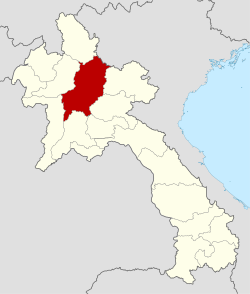Louangphabang Province
|
Luang Prabang ຫລວງພະບາງ |
|
|---|---|
| Province | |
 |
|
 Map of Luang Prabang Province |
|
 Location of Luang Prabang Province in Laos |
|
| Coordinates: 20°13′N 102°37′E / 20.21°N 102.62°ECoordinates: 20°13′N 102°37′E / 20.21°N 102.62°E | |
| Country |
|
| Capital | Luang Prabang |
| Area | |
| • Total | 16,875 km2 (6,515 sq mi) |
| Population (2015 census) | |
| • Total | 431,889 |
| • Density | 26/km2 (66/sq mi) |
| Time zone | UTC+07 |
| ISO 3166 code | LA-LP |
 |
|
| UNESCO World Heritage Site | |
|---|---|
| Location |
Laos |
| Area | 16,875.0 km2 (1.81641×1011 sq ft) |
| Criteria | ii, iv, v |
| Reference | 479 |
| Coordinates | 20°13′N 102°37′E / 20.21°N 102.62°E |
| Inscription | 1995 (19th Session) |
|
[]
|
|
Luang Prabang (also Louangphabang, Lao ຫລວງພະບາງ) is a province of Laos, located in the north of the country. Its capital of the same name, Luang Prabang, was the capital of Lane Xang Kingdom during the 13th to 16th centuries. It is listed since 1995 by UNESCO as a World Heritage Site for unique architectural, religious and cultural heritage, a blend of the rural and urban developments over several centuries, including the French colonial influences during the 19th and 20th centuries. The province has 12 districts, Luang Prabang, Xieng Ngeun, Nan, Pak Ou, Nambak, Ngoi, Pakseng, Phonxay, Chomphet, Viengkham and Phoukhouny. The Royal Palace, the national museum in the capital city, and the Phou Loei Protected Reserve are important sites. Notable temples in the province are the Wat Xieng Thong, Wat Wisunarat, Wat Sen, Wat Xieng Muan, and Wat Manorom. The Lao New Year is celebrated in April as The Bun Pi Mai.
Luang Prabang is the ancient capital of Lan Xang ("one million elephants") and is one of the oldest cities in Laos, founded approximately 1,200 years ago. It was previously known by two other names, Muang Sawa (or Muang Sua) and Xieng Dong Xieng Thong. It became the first capital of Laos in the 14th century when King Fa Ngum returned from Cambodia where he and his father were exiled by the previous king, Fa Ngum's grandfather. Fa Ngum had the support of the Khmer kingdom centered at Siem Reap and brought with him thousands of soldiers to assist in establishing his own kingdom. Luang Prabang was known as Muang Sua around the 11th century, but the settlement's name was changed after Cambodia gave a gold image of the Buddha, the Phra Bang, as a gift. The Phra Bang became the symbol of the city, and the Buddha image is on display at the museum. Nan-chao occupied Muang Sua in 709 and its princes or administrators replaced the Tai aristocracy. The occupation probably ended before the Khmer empire's northward expansion under Indravarman I (r. 877-89).
...
Wikipedia

